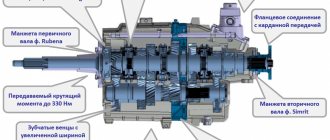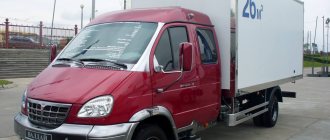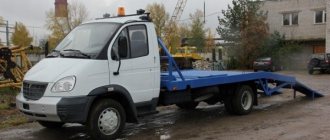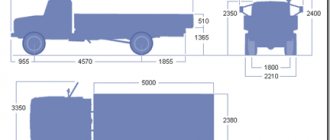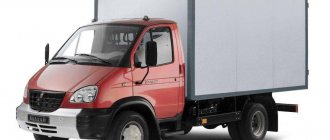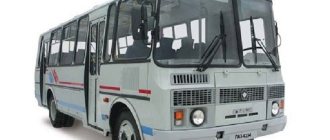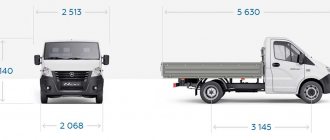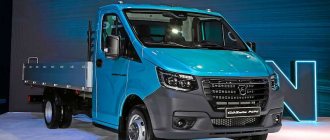At the end of the 90s of the last century, the Gorky Automobile Plant set itself the goal of creating a low-frame, medium-duty delivery vehicle, the model of which was in short supply on the domestic market.
The newly created car was equipped with segmented block headlights with a teardrop shape, a powerful bumper and a modified hood. The new model was called “Valdai”. At the beginning of 2010, a Cummins engine began to be installed on the 4-ton version of the Valdai.
Background to the appearance of the GAZ-33104 modification
It is difficult to say why in 1996 a license was acquired specifically for the “Alpine legend” - the Steyr M1 diesel engine, which had never been installed on any production car in the world either before or since. However, these engines, renamed GAZ-560, began to be equipped with a new series of medium-duty trucks from Nizhny Novgorod - GAZ-3310 Valdai.
Austrian Steyr engines were assembled at GAZ from imported components; further it was planned to establish their own production, with a design capacity of 250 thousand motors per year.
However, during direct operation of these economical engines at Valdai, it turned out that the reliability of the Steyr M1 leaves much to be desired. And the money saved on fuel is unlikely to be enough for their expensive repairs.
Experiments with the options proposed by Iveco and Perkins also turned out to be unsuccessful. Then it was decided to equip the GAZ-3310 Valdai with an automobile modification of the Minsk Motor Plant engine - D-245.7. For a long time they have been equipped with the ZIL Bychok truck, which is similar in performance characteristics to the Valdai. And, despite its “tractor origin” and the corresponding disposition (noisiness, vibration load), the Minsk engine performed well: it was not only economical, but also reliable and unpretentious.
Opinion
ROMAN DROZD, head of warranty department, official GAZ dealer, Moscow
— People regularly come to our service center for maintenance and repairs—mostly these are cars that belong to the first owners. Cases of serious breakdowns are rare; as a rule, minor faults are treated that require qualified intervention from specialists. Expensive repairs are usually associated with the failure of elements of the Common Rail fuel equipment, which are equipped in the engines of cars of the last six years of production. When refueling with low-quality fuel, the injectors are the first to suffer - a set of new ones costs about 70 thousand rubles, not including labor. The engines are generally quite reliable, especially the Cummins brand - the plant has been installing them on Valdai cars since 2010. The durability of the chassis directly depends on compliance with loading standards and timely maintenance of the machine. With regular overloads, as evidenced, in particular, by wheel rim rubbing on the tire sidewalls and oil leaks on the shock absorber housings, the springs soon fail. First, one sheet in the bag bursts, and then others too. The lining with which the package of sheets is tightened using stepladders often cracks; breaks in the stamped stabilizer brackets are also typical.
If the car is not overloaded (as a rule, these are chassis equipped with special superstructures, for example, car tow trucks), and the pin assemblies are regularly pressed, the chassis lasts for more than 100 thousand km without replacing parts. Steering rods - on average 80 thousand km, but when used on bad roads they may require replacement even with half the mileage. Some components from domestic suppliers are not yet durable or have a wide variation in quality. For example, the rear axle drive gear flange seal may leak after only serving 15 thousand km. Suddenly and regardless of mileage, failures of the electronic gas pedal module occur. On the other hand, there are also almost problem-free units. It’s quite rare to have to work on the brakes - branded German calipers serve without complaints for years. The plant modernized a number of vehicle units and systems, for example, the steering mechanism - as a result, the causes of jamming and oil leakage were eliminated. In other cases, a radical change in the supplier of components helped, in particular, the windshield wiper gear motor - now it is from Bosch.
Technical characteristics of GAZ-33104 "Valdai"
Engine D-245.7 for Valdai
The D-245 engines, produced by the Minsk Motor Plant since 1984, have a successful design and enviable potential: they turned out to be very promising for performing various upgrades. On the basis of this tractor power unit, the first Minsk automobile diesel engine was developed in 1992, which found its application on ZIL “Bychok” trucks.
It is interesting that the specialists of the Likhachev Plant were also looking for a motor for their medium-tonnage truck abroad and planned to set up its own production. And the involvement of D-245 was considered as a “temporary measure.” But - “there is nothing more permanent than temporary.”
In the early 2000s, in Minsk they developed and began to constantly develop, keeping up with the times, a purely “automotive” family of D-245.7 engines. It soon received widespread use. Not only on medium-duty trucks, but also on buses.
D-245.7 for Valdai is an in-line 4-cylinder diesel engine with a displacement of 4.75 liters and a power of 122 hp, with a maximum torque of 422 Nm. This engine is equipped with a turbocharger with an intercooler (pre-cooling of charge air).
Features of the entire “.7” family are the use of modern electronics, including the Common Rail microprocessor fuel injection system; as well as periodic “adjustment” of indicators to the increasingly stringent environmental standards: Euro-1, 2, 3, and then Euro-4.
Thus, until 2005, the D-245.7 engine complied with the Euro-1 standard; until 2008 – Euro-2, until 2013 – Euro-3; and since 2013 it has been upgraded to Euro-4. However, by this time Valdai had already begun to be equipped with more modern Chinese-assembled Cummins diesel engines. But most of the Valdai trucks were produced with Minsk engines.
- Cylinder diameter – 110 mm;
- Piston stroke – 125 mm;
- Compression ratio – 17;
- Rotation speed – 2400 rpm;
- Maximum torque – 422 Nm (43.1 kg m);
- Rotation speed at maximum torque is 1500 rpm.
- Overall dimensions of the engine – 948 x 698 x 970 mm.
- Weight (in modification E-2) – 477 kg.
Modification of GAZ-331043 “Farmer”.
The D-245.7 engine is equipped with a TKR 6.1-09.03 turbocharger (“BZA”, Borisov); gear pump NSh 10ZH-Z-04L; oil pump “245-1403010”; starter “7402.3708” (24V); generator GG 273V1-3 (26V); fuel pump “773.1111005-20.05E2” (“YAZDA”, Yaroslavl).
After 2008, in the modification D-245.7 E-3, the engine received a Common Rail diesel fuel supply system manufactured by Bosch.
The MMZ D-245.7 engine fits quite freely in the Gazelevsky engine compartment. However, GAZ specialists had to change the geometry of the front axle beam: make it lower by several millimeters. From below, the motor is protected by special pallets and covered with fire-safe basalt mats. The hood, mudguards, and engine compartment panel are equipped with a noise-insulating coating. In frosty conditions, the D-245.7 engine starts up well, since there are four glow plugs in the block head.
Transmission GAZ-33104
The Valdai transmission is based on the traditional GAZon gearbox, complemented by an imported Sachs single-disc diaphragm-type clutch. The gearbox is five-speed, its crankcase is cast from an aluminum alloy and is equipped with highly developed stiffening ribs. The gearbox connector is made in a vertical plane, and this allows it to provide additional high strength and rigidity.
This “old-new” five-speed gearbox engages clearly with a slight free stroke of the lever, which allows you to quickly and effortlessly change gears (an important factor, by the way, in inner-city operating conditions). Thanks to the precise operation of the gearbox, the GAZ-33104, despite being fully loaded, accelerates confidently and briskly. The range of gear ratios is from 6.55 to 1.0. That is, fifth gear is direct.
Exotic: truck tractor based on GAZ-33104.
The clutch of GAZ-33104 "Valdai" cars is permanently closed, single-disk, dry, with a central pressure diaphragm spring and a damper device on the driven disk.
The same thing, the virtually “indestructible” unit of the same name from the “honored veteran” - the GAZ-53 truck, the famous “banjo” - was taken as the basis for the rear axle. The hypoid single-stage gearbox was retained, however, taking into account the lower engine speeds and the significantly reduced wheel diameter compared to the 53rd “GAZON”, its gear ratio was reduced. At Valdai it is 2.417 - instead of the previous value of 6.83.
Frame, chassis, suspension, steering and brakes
The entire Valdai chassis is based on the frame of the classic five-ton GAZon. Thus, there is a significant margin of safety, and overloads, as a rule, go unpunished. The frame of the GAZ medium-tonnage truck is assembled from GAZ-3307 side members, with original cross-beams and brackets. Instead of the old springs on rubber cushions, the Valdai used longer, asymmetrical, small-leaf springs. The springs are secured with pins and earrings with silent blocks. This design will give the car a noticeable smooth ride, especially when loaded.
The steering mechanism is combined with a hydraulic booster, which significantly improves the maneuverability of the Valdai and its controllability. This is one of the key points for a truck intended for use mainly in the city. The Valdai wheels can be turned at an angle of up to 45 degrees. Due to this, the turning radius is six meters - and this is only half a meter more than that of the Gazelle (with its more modest dimensions and lower weights of transported cargo).
The revolutionary difference between the Valdai and any of its predecessors and “relatives” is the use of a pneumatic brake drive. None of the cars of the Gorky Automobile Plant in its entire rich history had anything similar. It is not surprising that they decided not to “reinvent the wheel”, but to use brake mechanisms (disc on all wheels), a pneumatic compressor and ABS elements produced by reputable European and Wabco (Germany), with pneumatic system units from (Italy).
Rear axle "Valdai" assembled.
Another distinctive feature of Valdai is the fastening of wheels according to the ISO standard. On the GAZ-33104 there are now no cone nuts and fittings, but there is a seat on the hub into which a disk and six ordinary nuts and washers fit.
It is interesting that the Valdai, initially, and with the Minsk engine too, was physically a “four-tonner with a reserve.” But its capabilities were underestimated on paper so that buyers would not fall under the state requirement for licensing transportation. But on June 2, 2005, this requirement was abolished by federal law, and the need for “camouflage of the muscular capabilities” of the vehicle disappeared.
Dimensions and weight parameters of GAZ-33104
- Length: 6.050 m (standard); 7.565 m (extended version to 5 m); 8.315 m (extended version to 6 m).
- Width: mirrors 2.643 m; in the cabin 2.164 m; along the loading platform 2,350 m.
- Height, cabin: 2,245 m.
- Front overhang: 1030 mm. Rear overhang: 1710 mm (standard); 2535 mm (extended).
- Wheelbase: 3.31 m (standard); 4 and 4.75 m (extended).
- Front wheel track, width: 1,740 m. Rear wheel track, width: 1,702 m.
- Ground clearance: 177 mm.
- Loading platform, length: 3,660 m (standard); from 4.9 to 6.2 m (extended versions). Width: 2.176 m. Side height: 515 mm. Height along the awning: 1,480 m. Overall height along the awning: 2,980 m. Loading height: 1070 mm - for an empty loading platform, 985 mm - for a loaded one.
- Max climb angle with full load: 25 percent (14 degrees).
- Vehicle weight (on-board, without arches and awning, in running order): 3,325 tons (standard), 3,610 and 3,545 tons (extended versions).
- Maximum lifting capacity of the Valdai, “according to the passport”: 3.925 tons (standard); 3,640 and 3,480 tons (for extended versions).
- The total weight of the basic version of the GAZ-33104 Valdai is 7.4 tons.
The main modifications of the GAZ-33104 "Valdai" are as follows: GAZ-331041 and GAZ-331042 - with extended wheelbases; GAZ-331043 - with an extended wheelbase and an enlarged double cabin (“Farmer” so-called). In addition, many special-purpose vehicles were produced on the GAZ-33104 chassis: tow trucks, sewer trucks, loader cranes, dump trucks, buses, cash-in-transit armored cars, mobile workshops, special vehicles for firefighters, rescuers and law enforcement agencies.
What breaks
According to reviews of carriers on the Internet, Valdai, as a rule, is purchased with the expectation of overloads and regularly takes on board about five tons. Therefore, the standard 17.5-inch tires from the Kirov plant fail quite quickly. Instead, owners install more heavy-duty ones - often Chinese ones. On the front wheels, Kirov tires completely lose their tread after about 30-40 thousand kilometers, and no wheel alignment adjustments help - only replacing the tires with branded ones. To increase the survivability of the rear suspension, many Valdayev owners add sheets to the springs and scald the stabilizer brackets with corners. It is imperative to strengthen the rear suspension bracket of the power unit by welding additional metal - it is near the gearbox, on the left, and breaks due to variable loads when the engine is bumpy and on rough roads. It is advisable to install an additional, second clamp on both ends of the tie rod: otherwise the hinge can easily be torn out.
Almost everyone who has driven a car with a Minsk engine and then purchased another one with a Cummins engine characterizes the changes with expressions like “heaven and earth.” “Valdai” from MMZ is a typical domestic truck, in which only German brakes please: powerful, reliable and durable. Even “consumables” - brake pads - sometimes last 100 thousand km. Everything else is unpredictable, up to the destruction of the piston pins - suddenly, and for no apparent reason. And it’s not even worth talking about the regular failure of attached units and oil leakage through gaskets - phenomena familiar to our cars. MMZ engines are distinguished by unstable build quality: one engine can last 400 thousand km before repair, almost without failures, while another will pester the owner with malfunctions almost weekly. With an American-Chinese “heart,” the car has been transformed—you don’t have to look under the hood for a long time. But everything that does not relate to the engine and brakes, or rather, was taken from previous models of the GAZ plant, is still “at risk.” Of course, both clutch cylinders regularly require overhaul and replacement of cuffs - the main one transfers fluid into the reservoir, forcing the driver to apply pressure on the brakes and turn off the engine at the slightest delay in starting at a traffic light, while the working one simply leaks. Both of them, introduced on the Volga GAZ-21 and then on the GAZ-66, have undergone a series of minor upgrades over half a century, but to no avail. Oddly enough, the only thing that helps is replacing the modern glycol fluid in the hydraulic drive with the ancient red alcohol-castor BSK - it is still on sale.
Cabin of the GAZ-33104 Valdai car
The cabin of the Valdai vehicles is maximally unified with the Gazelevskaya. You could even say that they are identical. Minor changes were made to the bumper and radiator grille. The bumper is more massive and consists of three parts. Another point: the cabin now has steps, since it is noticeably higher than the Gazelevskaya. The mirrors are increased in size, mounted on different brackets and equipped with electric heating.
The interior and level of comfort in the Valdai cabin are almost the same as in the Gazelle. The workplace can be adjusted to suit a person of almost any build and height: the steering column moves both in height and in angle of inclination. And the driver's seat varies in height. When traveling short and medium distances, the comfort in the cabin is quite sufficient. It’s not enough for a long-range driver: a sprung seat wouldn’t hurt.
Owner reviews about GAZ-33104 “Valdai”
Most owners and drivers of the GAZ-33104 Valdai car characterize it as the optimal medium-tonnage vehicle for intracity transportation, as well as for short- and medium-range intercity flights. This is a full-fledged truck, practically possessing the handling, acceleration and maneuverability of a passenger car.
There is no doubt about the ability of the Valdai to take on board and freely transport not only the 3.9 tons required “according to the passport”, but also more (4.5 and even 5 tons): there are many examples of this, and absolutely everyone has had this experience successful.
Unless you constantly and systematically overload the car: then it begins to appear that the suspension - silent blocks and springs, anti-roll bars - is still not designed for regularly inflated loads. The durable frame that Valdai inherited from the classic GAZONs does not even notice overload.
There are no complaints about the power, throttle response and thrust of the D-245.7 engine: “This turbodiesel is power! Pulls in any gear, at any speed.” There are complaints about excessive noise and vibration of this engine. Everyone, even the most devoted supporters of Valdai cars, points out these shortcomings.
Especially after it was possible to compare the performance of the D-245.7 not only with the engines on other “classmate” trucks, but also with the Cummins ISF-3.8s3154 diesel engine on the Valdai itself, a modification of the GAZ-33106. The comparison was clearly not in favor of the Minsk engine.
The car's brakes deserve high praise - pneumatic and all disc, expensive, German-made, like those on a Mercedes Atego. Despite the fact that disc brakes, by tradition, are considered very gentle, not liking dirt and salts. They are expensive, but they work excellently, including in icy conditions. ABS works simply, it bleeds out excess air. There is a Wabco dehumidifier that removes condensate from the air. Valdai maintains pressure in its circuits better than KamAZ, up to a week.
The main thing that all owners note is that Valdai is a working machine that brings in real money. And if you look after her properly, she will not let you down. Cargo transportation in our time is not a simple matter. And, if you buy a car for business, then in comparison with fairly used imported “classmates”, a relatively “fresh” Valdai for the same money looks preferable.
Opinion
RUSLAN YAKUBOV, individual entrepreneur Moscow
— The Valdai car with the MMZ-245 engine has been working with us on customer calls for the seventh year now, but the total mileage is still small - only about 40 thousand km. The vehicle has a side-tent body and a wide variety of cargo, except food. We travel mainly around Moscow and the region, but there are also orders for flights to neighboring regions, including on bad roads. However, the chassis of the car has not yet required repairs - no play was found in the pivot joints of the front axle and the steering linkage hinges during the last inspection. The engine and transmission are also in perfect working order. Among the little things, I will note the periodically dropping voltage of the generator, as evidenced by sharp deviations of the ammeter needle. But so far there has been no critical battery discharge. The tires on the front wheels have already had to be replaced with Cormoran ones of the same size; the rear wheels still have original ones. Fuel consumption on the highway is about 16 l/100 km, in the city - about 20 l/100 km.
